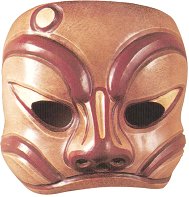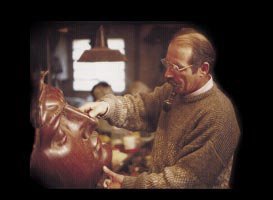Commedia Mask Museum: Amleto and Donato Sartori
After World War II, the Italian intellectual community was searching for their cultural and historical roots. A number of theatre people started to explore commedia dell’arte, which at that time when it was performed was being done as stodgy museum pieces really devoid of life (think bad Moliere) A group of artists, including Giorgio Strehler, Dario Fo, Jacques LeCoq, Marcello Moretti, Carlo Mazzone-Clemente, Ferrucio Soleri, and Amleto Sartori began to collaborate and experiment together and in various different combinations. It wasn’t organized all together– a number of people were searching for similar ideas. And some of them searched together.
Several of the above mentioned had contacted Sartori, a Paduan sculptor, about re-creating leather commedia masks. Sartori (and later his son Donato) really re-invented and re-created the how and the what of how to make commedia masks, relying on old paintings, etchings, descriptions of tools and some surviving wooden molds, Sartori created some beautiful masks that most importantly were able to be used by actors to convey tremendous amounts of feeling and vitality while still being sculpted work.
The Sartori’s now have a museum in Padua (CENTRO MASCHERE E STRUTTURE GESTUALI)Â that is both a museum for the work of the Sartori’s and other maskmakers, but a place where masterclasses and experiments continue to be held. To find out more about the museum, visit their Italian website: http://www.sartorimaskmuseum.it/ (the site is a little outdated, and the English parts and the Italian parts aren’t the same at all)



Pingback: Guest Post: What makes a Great Commedia Mask? by Stanley Allan Sherman
Pingback: Buon Viaggio | making faces
Pingback: How Are Theater Masks Used Today by Jonathan Becker